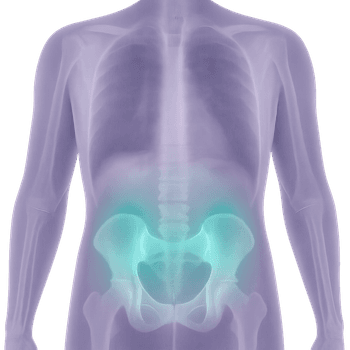Quick version
The hip is an important joint for mobility and weight-bearing, but can be affected by both stress injuries and age-related conditions.
- Stable ball-and-socket joint between the femur and pelvis
- Enables walking, running and rotation of the leg
- Common problems are osteoarthritis, bursitis and impingement
- Symptoms include pain, stiffness and reduced mobility
- Investigated with clinical examination and imaging
What is the hip?
The hip consists of the hip joint, where the head of the thigh bone (femur) meets the pelvic socket (acetabulum). It is one of the largest joints in the body and has both stability and great mobility. The hip is surrounded by strong muscles, ligaments and cartilage.
Anatomy and structure
The hip joint is a ball and socket joint with a deep joint space for stability. The The head of the thigh bone is covered by articular cartilage that reduces friction. Surrounding the joint are the hip capsule, ligaments and important muscles such as the glutes and hip flexors. Nerve supply is from the sciatic nerve and other nerves in the lumbar spine.
Movements and function
The hip allows flexion, extension, inward and outward rotation, and abduction and adduction of the leg. This function is crucial for walking, sitting, standing, and performing physical activities.
Stability and load
The hip supports the entire body's weight when walking and standing. Its stability comes from the shape of the joint, surrounding muscles, and ligaments. Imbalances in the muscles or incorrect loading can lead to pain and wear and tear.
Common conditions and diseases
Pain in the hip can be due to osteoarthritis, inflammation of the bursae (bursitis), hip dysplasia, or muscle tension. In younger people, impingement (FAI) and overuse are common, while older people often suffer from osteoarthritis or hip fractures.
Examination and diagnosis
Diagnosis is made through history, physical examination and tests of mobility and pain. Imaging diagnostics such as X-ray, ultrasound or MRI of the hip are used to see cartilage, bone and soft tissues. Blood tests such as CRP and SR can rule out inflammation or infection.
Relevant symptoms
- Pain in the groin, buttock, or outer hip
- Stiffness in the hip, especially in the morning
- Difficulty walking, standing, or bending
- Clipping or locking in the hip joint
- Radiating pain down the leg
Related conditions and diagnoses
- Hip osteoarthritis
- Bursitis (inflammation of the bursa)
- FAI – femoroacetabular impingement
- Hip fracture
- Hip Dysplasia





















